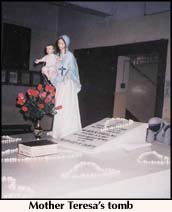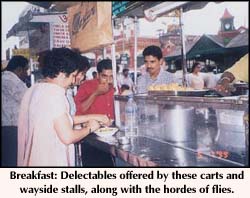
17th October 1999
Front Page|
News/Comment|
Editorial/Opinion| Business|
Sports|
Sports Plus| Mirror Magazine

![]()
Chequered history, culture and Calcutta
Whatever paradoxical name by which Calcutta may be called, "Hell Hole" or "City of Joy", it is definitely a city with a soul
By Kumudini Hettiarachchi
It was a walk into the past. Whether trundling along the busy and dirty streets in a ramshackle tram, being pulled on a rickshaw on the shoulders of a young Bengali with rippling muscles or just walking among the teeming humanity, Calcutta seems to be caught in a time-warp.
The dust, the muck, the slums, the all-pervading odour of urine.....it is so similar to any other overcrowded Indian city, but at the same time has a distinct flavour of its own. As someone said the other day, just as power rules Delhi, money rules Bombay, tradition calls the shots in Madras, culture rules in Calcutta. That is apparent even on the streets, where books, books and more books are for sale and the humblest wayside hawker has Tolstoy and Chekhov spread out on the pavement.
Being one of the two states (the other being Kerala) with communist governments, it is, most Bengalis think the only city in India and maybe even the world where this road is dedicated to Lenin and that square to Karl Marx.
Whatever paradoxical name by which Calcutta may be called, "Hell Hole" or "City of Joy", it is definitely a city with a soul. India's greatest poets, thinkers and artists — Rabindranath Tagore who wrote the Gitanjali to mention just one — have been born and nurtured here.
All the vicissitudes the city, as the capital of West Bengal has faced, have left the over 10.5 million people extremely proud of their rich heritage and culture. Calcutta has a chequered history. Way back in 1687, Job Charnock an agent of the East India Company had secured permission from the Mughals to establish a base at Sutanati and in 1696 Old Fort William, the origin of the city of Calcutta, was set up by the British. Calcutta had been derived from Kalikata (site of a famous Kali temple), one of three villages whose land became part of the new settlement.
The city served as the British capital of India until 1911 and the Victoria Memorial with its storehouse of Raj memorabilia, is still the city's landmark.
In more modern times, Calcutta along with Bengal was caught in the partition, as the British divided India and gave Pakistan a half of that state - East Bengal. Partition not only left families divided, but also created much poverty as millions of refugees flowed into West Bengal. The problems were still not over.
When India invaded East Bengal and established Bangladesh in 1971, more refugees poured in and political unrest, naxalite movements and industrial strikes have caught the state in their vice-like grip
 But,
Calcutta is also the "land" of Mother Teresa. The morning after
I landed in Calcutta recently, I had to see the place where she operated
from.
But,
Calcutta is also the "land" of Mother Teresa. The morning after
I landed in Calcutta recently, I had to see the place where she operated
from.
For me, no tour of Calcutta would be complete without a stop at her "Mother House", where she brought in the beggars and the lepers, the old and the feeble and tended to them, clothed and fed them.
So it was a trek out of the hotel, into the bustling streets packed with people, beggars, hawkers and vehicles whizzing past without a care for the pedestrians and with the drivers permanently leaning on the horn. All the people on the street knew of Mother Teresa's home. They stopped and gave directions, some even walked part of the way.
The Bengalis are very warm people, also very volatile and within seconds there could be a traffic jam with a cab driver being pulled out and angry gesticulations and a fracas.
This part, I suppose is very familiar to Sri Lankans, after viewing their shocking behaviour during the World Cup game between Sri Lanka and India at Eden Gardens in 1996.
 Anyway,
the best way to get to know a city is to walk and we saw life in the raw
that day on the streets of Calcutta. At one intersection, about 10 weavers
were gathered with their tools and cane, all ready to make the pavement
their workshop for the day. Further up it was a barber seated on a stone
in the corner with a client twisting his face for the morning's shave,
and grimacing as the razor nipped his chin. There were the numerous food
stalls dotting the streets and it seemed as if most Bengali men, women
and children had not been able to get breakfast at home, but were enjoying
the delectables offered by these carts and wayside stalls, along with the
hordes of flies.
Anyway,
the best way to get to know a city is to walk and we saw life in the raw
that day on the streets of Calcutta. At one intersection, about 10 weavers
were gathered with their tools and cane, all ready to make the pavement
their workshop for the day. Further up it was a barber seated on a stone
in the corner with a client twisting his face for the morning's shave,
and grimacing as the razor nipped his chin. There were the numerous food
stalls dotting the streets and it seemed as if most Bengali men, women
and children had not been able to get breakfast at home, but were enjoying
the delectables offered by these carts and wayside stalls, along with the
hordes of flies.
And myself and a journalist from Madras walked on as everyone said Mother Teresa's home was "very close". A right turn here, a left there, but there was no sign of the "Mother House". The humidity was becoming unbearable and we decided to take a tram, but "No. 20" never came. The last resort was a yellow-topped cab, after an argument on the fare. Suddenly, we were there, with the "Missionaries of Charity" plaque staring us in the face.
The building looked like any other on the street. Down its side was an alley occupied by a few stragglers, who readily guided us to a simple door, with a rope hanging out.
A tiny tug, and the door just opened as if the very young novice in her white robes was standing by it, awaiting us. We explained our "mission" and were told to sit on a cement bench. Then came pretty Sr. Christo in her simple white saree with its blue border, explaining in soft tones that "Mother Nirmala and the community had decided that for sometime they should continue their work without any media publicity." It was somewhat like a "blackout".
So seeing the homes, especially Shishu Bhavan for sick children, set up by Mother Teresa was not possible, but we were welcome to sit at her "tomb" and take away some medals.
"Nothing is for sale here. We just give out medals and small leaflets about her," Sr. Christo said, while leading us through the "Mother House" to a large hall, the walls of which were covered with a collage of pictures and writing on the life and times of saintly Mother Teresa. Shoes off, we tread softly into the hall and are greeted by absolute silence.
A large white tomb dominates the hall and groups of foreigners sit cross-legged on the floor and the chairs lining the walls, praying and meditating. A single nun sits near the door, as if keeping vigil. Over the tomb, looking benignly down is the statue of Mary with baby Jesus in her arms. The tomb is white marble, sans any frills. Mother Teresa's much-thumbed personal Bible, a single vase with roses and a lamp casting a red glow, lie atop the tomb.
Garlands of white jasmine, seemingly threaded with much love into heart-shapes, adorn the tomb..........and there is peace, as if Mother Teresa moves in spirit among the people she loved and cared for. The people for whom she left her home and family in Albania.
We leave the Mother House with the words Mother Teresa wrote on the ship to India on December 9, 1928, imprinted on our brain:
"I leave the house that gives light to my heart,
My country, my entire family.
My goal is Bengal, prostrate with suffering,
A land dear to me, although it is a foreign land."
Mother Teresa is truly a part of Calcutta.








![]()
Front Page| News/Comment| Editorial/Opinion| Plus| Business| Sports| Sports Plus| Mirror Magazine
Please send your comments and suggestions on this web site to

